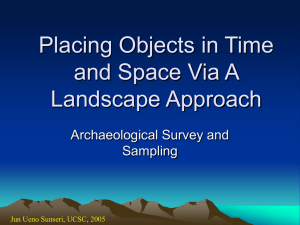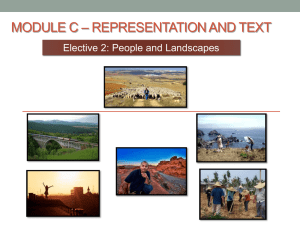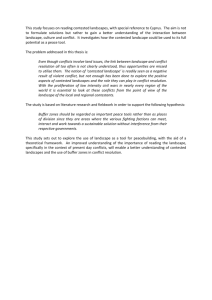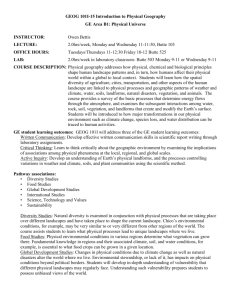Iceland`s landscape........Hot springs, active rift zone & Jokulhaup
advertisement
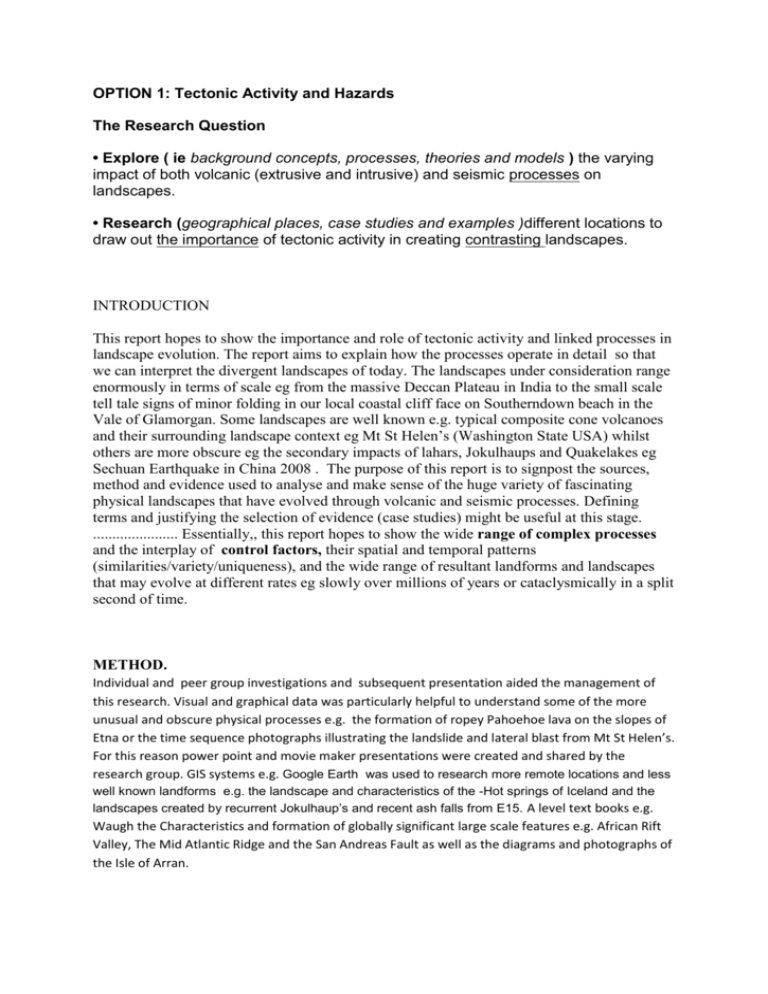
OPTION 1: Tectonic Activity and Hazards The Research Question • Explore ( ie background concepts, processes, theories and models ) the varying impact of both volcanic (extrusive and intrusive) and seismic processes on landscapes. • Research (geographical places, case studies and examples )different locations to draw out the importance of tectonic activity in creating contrasting landscapes. INTRODUCTION This report hopes to show the importance and role of tectonic activity and linked processes in landscape evolution. The report aims to explain how the processes operate in detail so that we can interpret the divergent landscapes of today. The landscapes under consideration range enormously in terms of scale eg from the massive Deccan Plateau in India to the small scale tell tale signs of minor folding in our local coastal cliff face on Southerndown beach in the Vale of Glamorgan. Some landscapes are well known e.g. typical composite cone volcanoes and their surrounding landscape context eg Mt St Helen’s (Washington State USA) whilst others are more obscure eg the secondary impacts of lahars, Jokulhaups and Quakelakes eg Sechuan Earthquake in China 2008 . The purpose of this report is to signpost the sources, method and evidence used to analyse and make sense of the huge variety of fascinating physical landscapes that have evolved through volcanic and seismic processes. Defining terms and justifying the selection of evidence (case studies) might be useful at this stage. ...................... Essentially,, this report hopes to show the wide range of complex processes and the interplay of control factors, their spatial and temporal patterns (similarities/variety/uniqueness), and the wide range of resultant landforms and landscapes that may evolve at different rates eg slowly over millions of years or cataclysmically in a split second of time. METHOD. Individual and peer group investigations and subsequent presentation aided the management of this research. Visual and graphical data was particularly helpful to understand some of the more unusual and obscure physical processes e.g. the formation of ropey Pahoehoe lava on the slopes of Etna or the time sequence photographs illustrating the landslide and lateral blast from Mt St Helen’s. For this reason power point and movie maker presentations were created and shared by the research group. GIS systems e.g. Google Earth was used to research more remote locations and less well known landforms e.g. the landscape and characteristics of the -Hot springs of Iceland and the landscapes created by recurrent Jokulhaup’s and recent ash falls from E15. A level text books e.g. Waugh the Characteristics and formation of globally significant large scale features e.g. African Rift Valley, The Mid Atlantic Ridge and the San Andreas Fault as well as the diagrams and photographs of the Isle of Arran. The evolution of the Volcanic Islands of Hawaii from a hot spot plume of convection currents through the mantle were researched by examining animations from the USGS website. The British Geological Survey website enabled more technical process eg the formation of batholiths and sills to be researched .This was useful to grasp the processes operating under the crust and on the surface in a simple graphical way. In addition, The Birth of Britain (Channel 4) and Men of Rock (BBC2) TV series that allowed the evolution of the theoretical background to geology to be examined. Fieldwork in Wales offered some insight into localized folding and fossilized and relic features in Snowdonia. In addition Virtual Fieldtrips were used (these had been developed in the school geography department) from photos taken on a trip to Sicily and the Aolian islands of Stromboli and Lipari last year. Landforms and landscapes of The British Isles Perhaps most surprising misconceptions exist about the formation of the landscapes of Britain. In the TV series the Birth of Britain, (Nat Geo / HD -) Tony Robinson sets out to reveal that while we might not be aware of it, our current landscape gives significant clues to the awesome volcanic and tectonic processes that shaped the British landscape around 450 million years ago. Evidence from present landscapes and reveals the variety of drama of the creation of the British landscape is far from mundane. While the British Isles may seem calm today, there is a misconception amongst many people that our geological past was rather unremarkable. In fact , our past was as violent and dramatic as anywhere else on Earth (the North Wales eruptions were of higher magnitude, for example. than Krakatoa.. It is amazing to find out that Snowdonia was once a place resembling ‘Armageddon’ with vast rivers of lava, ash falls, volcanic bombs and pyroclastic flows creating the legacy landcape of today. Landscape evidence suggests that hot ash was blasted high in the air when a volcano erupted at Conwy, leaving great piles of lava which formed Mynydd y Dref, spreading out to Snowdonia. A closer look during fieldwork visit to Snowdonia shows photographs of small scale features eg fossilised pillow lavas, rocks impregnated with stones from another source, and small basalt intrusions that have been subsequently exposed. On a larger scale 20ft synclines in Cader Idris can be seen where the rocks have been contorted by folding and fractured by seismic pressures. Even more locally, similar processes can be identified by looking at photographs and field sketches from the eastern end of Southerndown beach (along the Vale of Glamorgan Heritage Coast) . Here subsequent uplift and coastal erosion have exposed the evidence of severe and extensive folding in the current cliff face. Further afield, In the Lake District, one of Britain’s most popular tourist destinations, the Cumbrian mountains (including England’s highest peak Scafell Pike) were formed by erupting volcanoes when the North American and Eurasian continents collided. Subsequently, ice also shaped the Lake District, carving the area’s iconic thin and deep lakes, making it one of the most beautiful places in Britain. The classic (text book) example of the Isle of Arran reveal the importance of intrusive processes in determining current landcape features.....The Great Whin Sill...Hadriens Wall...High Force waterfall..... The Theory. Naturally, understanding global scale tectonic processes, the age and characteristics of different rocks, the characteristics of different plate boundaries and their associated landforms and a classification system for landscapes and landforms are important to unravel the mysteries of landscapes. Researching a theoretical framework was equally tricky. The series Men Of Rock (BBC 2) reveals that the geological processes involved have often been wrongly interpreted by the past scientific communities. Whilst current thinking and understanding about plate tectonics is being continually being refined today by key players like the USGS, BSG, university geology departments, the story of the science itself is fascinating. In the past, wrong turnings, red herrings and dogma have typified advances in learning in this sphere. Clues have been pieced together like a jigsaw. Evidence has been wrongly interpreted and overgeneralisations made. Leaps of discovery by the most unlikely characters have not being recognised for generation to come. For example, James Hutton’s ideas about the age of the rocks of Britain and their volcanic origin was dismissed in the 18th century. His ideas were seen as fanciful or even heretical by the main stream scientific community which believed for a long time that the earth was thousands rather than millions of years old and that the rocks of Britain were laid down during biblical floods. This idea of the ancient sea origin of our landscape with older rocks simply underlying younger ones in sequence prevailed until bits of the jigsaw evidence did not appear to fit, the idea was challenged and a new conception began to emerge. Similarly the mechanics and evidence for explaining and supporting Alfred Wegner’s continental drift theory did not emerge until at least 50 years after he proposed it.............. Keep this Brief/mention any other relevant scientists/ideas Volcanoes as landforms Active, dormant or extinct and heavily eroded Volcanoes can significantly dominate some landscapes eg Etna on the island of Sicily. Volcanoes are both hazards and landforms. They are controlled by the geological processes that form them and act on them after they have formed. Thus, a given volcanic landform will be characteristic of the types of material it is made of, which in turn depends on the prior eruptive behaviour of the volcano. Although later processes can modify the original landform, we should be able to find clues in the modified form that lead us to conclusions about the original formation process. Classification systems vary but ,for the purpose of this rep[ort....The main types are..... Transformation of the Landscape around Mt St Helens On 18 May, 1980, in northwestern USA, the Mount St. Helens volcano erupted and devastated vast areas of land, including virgin and managed forests. During this enormous volcanic explosion, most of the former cone-shaped mountain tops of Mount St. Helens disintegrated into dust, ash, mud and gas. Two and a half cubic kilometers of rock slipped off the north face within a few seconds, accompanied by gigantic cloud of ash. The material mixed with ice and glacier ice created LAHARS. The material deposited itself mainly in the area of 600 square kilometers and covered virgin forests with thousands of elks, mountain goats and cougars. During this inferno, 57 people died. Since this eruption, nature has returned to its complete diversity. Most of the animal and plant species which existed before the eruption repopulated the flood plains and mountainous regions in the protected areas and those species which took advantage of the open landscape and the numerous new water bodies immigrated into this landscape. Outside of the protected areas forestry is prospering again. This volcano was... This case study illustrates that....... In Contrast...... Iceland’s landscape........Hot springs, active rift zone & Jokulhaup transforming surrounding area. Hot springs occur in many places around the world including Iceland (Google Earth). They are found where hot magma has worked its way quite close to the earth’s surface. Rainwater filtering downwards through the rocks comes into contact with this magma, is heated by it, and then bubbles back towards the surface as a hot spring. The active volcanic area of Iceland, Japan and New Zealand have large numbers of hot springs. They are also found in older, dormant volcanic areas, such as the Yellowstone National Park in Wyoming and the Snake River Plateau in Idaho, both in the USA. The Hawain Islands The Deccan Plateau The African Rift Valley The San Andreas Fault/ Fold mountains The Secuan Earthquake and The Indian Ocean Tsunamis Conclusion In conclusion, a wide range of landscapes can be attributed to tectonic activity. The processes may be catacysmic or imperceptibly slow. The chemical composition and heat of the intruded or extruded material seems particularly significant as is the nature of the existing rock into which volcanic intrusions are made. The nature, frequency and magnitude of the volcanic and/or seismic episode seems equally significant. Relic landscapes may undergo significant modification but evolution can be interrupted by a resurgence of tectonic forces. The earth’s landscapes are arguably more dynamic, complex and significant than we might first imagine. In Britain, for example,If we think carefully about the rocks beneath our feet-we find that almost everything about our country – its look, the position of its towns and the hills and valleys themselves – have been forged by our momentous geological past. Whilst very significant glacial and fluvial processes may have carved and refined the landscapes around us –arguably, it was earth movements and processes operating from under the surface that have provided the most significant(yet often surprising) blue print for the landscape of today.



